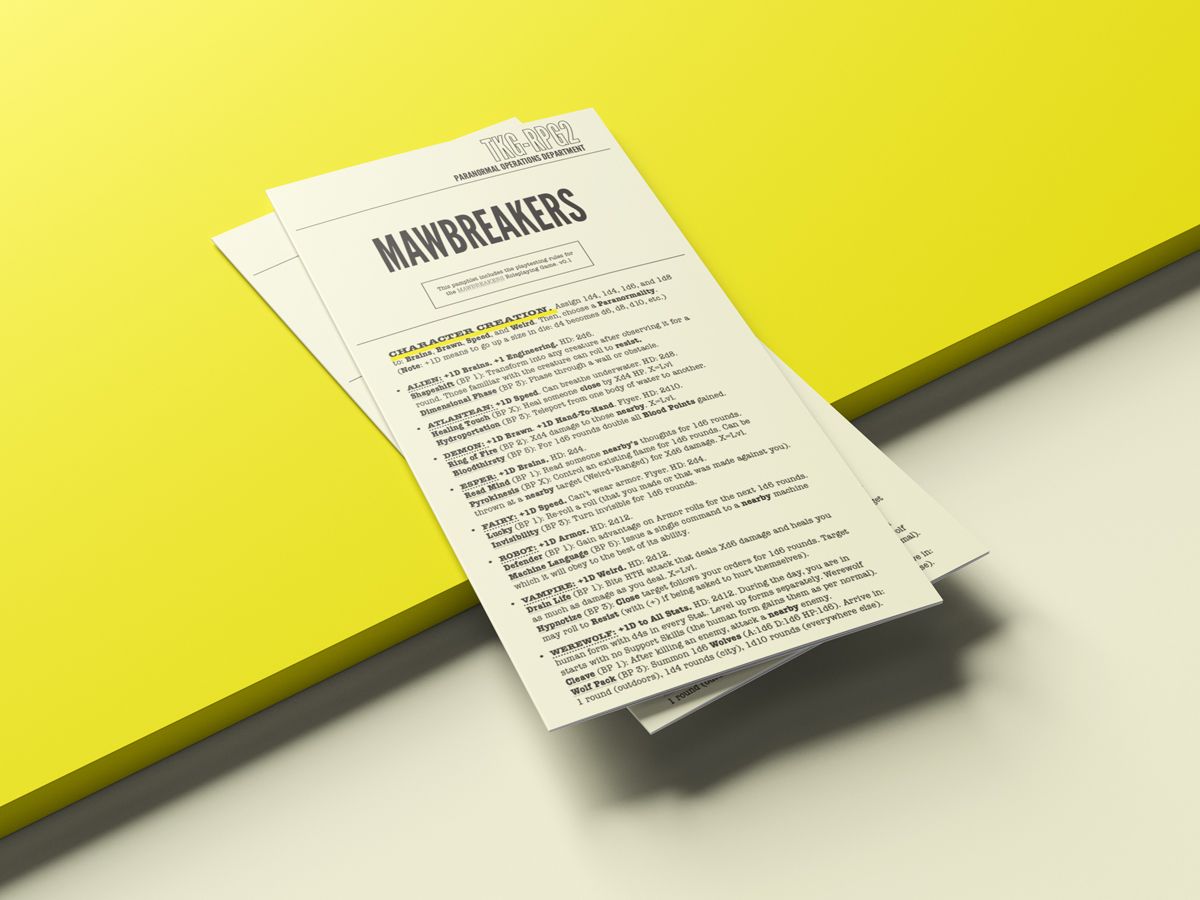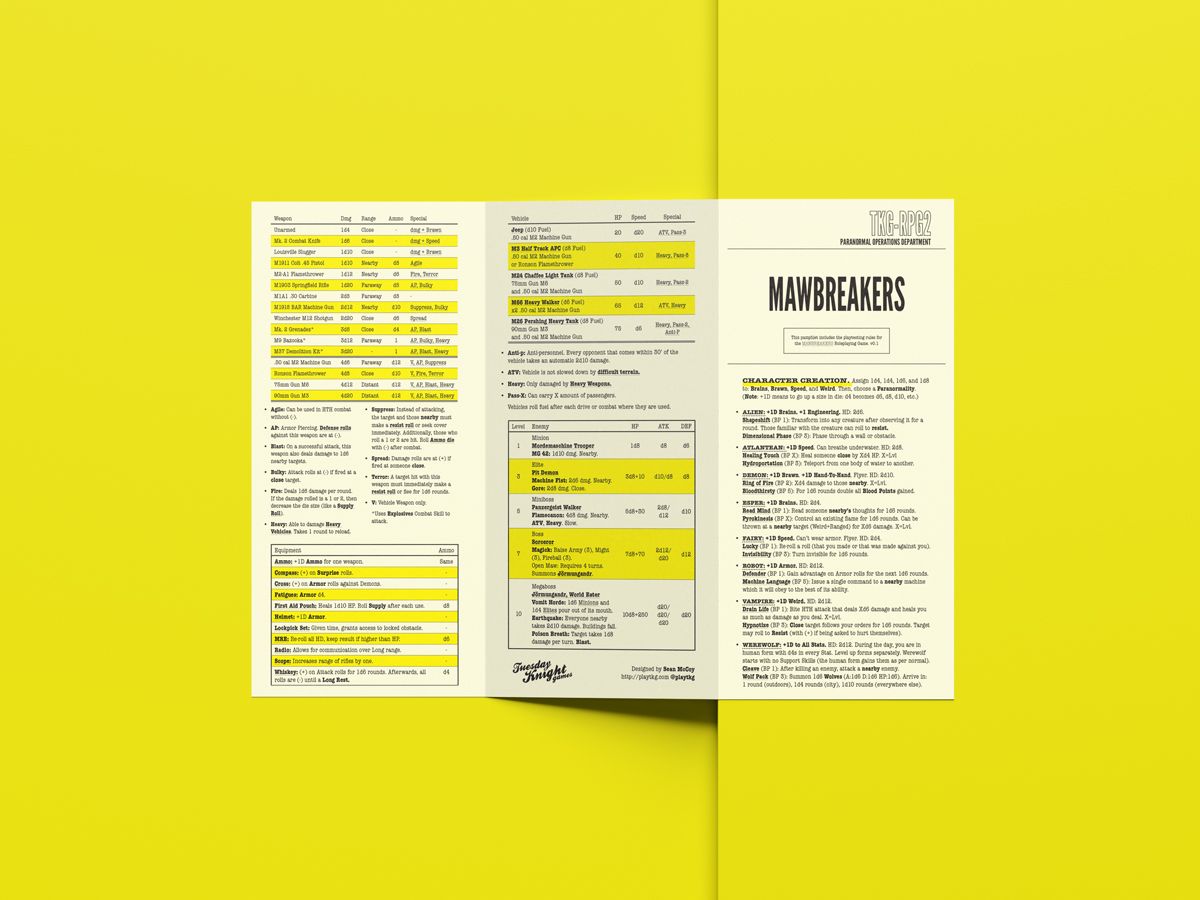Mawbreakers, Resource Management, and Combat Centric Gaming
December 16, 2019 rpgs lessons_learned mawbreakers game_design playtesting
Shortly before Langston was born I was reading a lot of Hellboy and I found myself wanting to play a paranormal WW2 game with some Wolfenstein or DOOM style action thrown in. I slapped together a hack of Stay Frosty, called Mawbreakers and ran a playtest with my home group. They were interested in seeing more but the game wasn’t action packed or paranormal enough for them. I was running it too much like Mothership. High fear. Slow burn.
Langston’s six eight months old now and after doing a sprint to get A Pound of Flesh finished I wanted a creative palette cleanser, so I cracked open Mawbreakers again in anticipation of running a playtest at Gen Con.
Time and distance help a lot with a project.
I went through Stay Frosty’s forebearer, The Black Hack, and through Savage Worlds as well. I’ve hacked together a pamphlet RPG ruleset that’s light enough for me to playtest but complete enough for me to call a game. I like to work in compete drafts. Even if they’re little.
I’ve put the pamphlet PDF up on itch for a dollar, if you like it or have any feedback from playing let me know.
 We gave out a few of these on request at Gen Con this year. I kinda love the format.
We gave out a few of these on request at Gen Con this year. I kinda love the format.
The basic pitch is that youre a squad of paranormal commandos in World War 2. You can be a Vampire Chaplain or a Fairy Saboteur or an ESPer Spy or a Demon Grunt. It’s a fast-paced combat-centric action game based on accumulating a Blood Points (BP) by killing enemies1. You then spend your BP to activate your paranormality’s (essentially your class) special Blood Powers.
This is the core part of the game that I think is interesting: Blood Points are essentially mana that you get through kills. However, they also can be used like “Bennies” from Savage Worlds. They allow you to add +1 per BP spent to any roll you make. Almost all rolls are opposed rolls in Mawbreakers, so this might be an attack or a skill check or an armor save. They also let you heal 1d4 hp. They’ll activate certain magic weapons. If you’re a Chaplain (spellcaster) you use them to cast spells etc.
The catch is that Blood Points also serve as your XP. Any unspent BP at the end of the session is automatically converted to XP at a 1-to-1 rate. You start each session with a small amount of BP (1d6) as both a reward for playing (it operates like a kind of survival bonus) as well as a way to jumpstart to your BP engine (since you can spend them on Blood Powers that help you kill more enemies which then leads to more BP).
I like the choice this creates in a combat heavy game. Do you bank the BP you’ve earned and hope to level up and unlock more cool special abilities? Or do you spend the BP taking down a huge boss to in hopes of making it rain BP on everyone?
In a game where killing is at the core, I actually wanted a faster frenetic combat style as opposed to a more drawn out tactical battle. Fast 4e is my mantra. I think BP helps accomplish this. Every kill increases the likelihood of another kill, and another, and another. You gain momentum (like in the 2d20 games).
Likewise the lethality on the players is turned way down. PCs are either Up, Down, or Out.
- PCs who are Up are active, playable, moving around, killing Nazis, etc.
- PCs who run out of HP are Down. Knocked out or unconscious. They’re out of the fight. Down PCs get Up again after combat. They can also be revived by any healing (like spending a BP to gain 1d4 HP). Or by a comrade sacrificing an action to stabilize them (and give them 1 HP) with a First Aid Kit.
- PCs who take damage while Down are Out. They dead.
- During a short rest, PCs can eat an MRE to re-roll their HP and keep the new roll if it’s higher than their total.
The goal isn’t to make combat lethal and therefore scary. It’s to make it fast and see how you can combo kills to earn more BP faster.
I’ve tiered out enemies to be either Minions, Elites, Minibosses, Bosses, and Megabosses. Most minions should be one hit kills. But if you’re fighting a lot of minions you need to get creative with AOEs and the environment because really what limits you at that point isn’t damage output, it’s the action economy. If you only kill one enemy per turn, you’ll be overwhelmed quickly. Players are encouraged to think about solving combat like you’d solve a puzzle.
This leads me to another area of design which I think needs more discussion: environmental obstacles and tactical advantages in combat.
 We packed a lot into this tri-fold. Classes. Paranormalities. Abilities. Weapons. Vehicles. There’s even a small monster list.
We packed a lot into this tri-fold. Classes. Paranormalities. Abilities. Weapons. Vehicles. There’s even a small monster list.
A lot of old school DMs are big into forcing the players to think creatively. Turning over tavern tables for cover, etc. But we don’t have a lot of good examples of people who are doing that sort of thing in design. Writing interesting tactical setups for combat that can be run without a grid.
I’m talking largely about creating set-pieces with a lot of kinetic potential. Explosive barrels. Weak bridges with whole squads on top of them. Vehicles or cannons that are lightly guarded or unmanned. Water towers.
Basically anything that can be interacted with in combat in an interesting way that dynamically changes the situation.
Players best options in most games is just to attack with their biggest weapon and then work down from there. Interacting with the environment needs to give you a higher potential damage output than your sword or spell. “I attack” should be a good baseline, or a last resort, if you can’t think of anything better to do. But in Mawbreakers all the Blood Powers are specifically aimed at changing the tactical situation.
So that’s one of the unique challenges of making Mawbreakers fun. 1d6 Stormtroopers isn’t a good encounter unless I can also generate the immediate tactical situation. Some of this is apparent with a map, but not with a lot of maps. My random encounters also need obstacles and toys. 1d6 stormtroopers barely containing a pit demon in chains while 1d6 other storm troopers load up a truck with explosive ammunition. That’s a much much better encounter for my players. They come upon a scene. There brains start ticking about what they want to do outside of attack.
Good combat is like a meal where the referee provides the ingredients for the players to cook.
Another design issue: the mechanics of most RPGs revolve around resource management. The biggest one in most games is your HP your number of actions. You’re trying to accumulate XP though you rarely lose XP so that’s not a resource you manage as much as it is one you acquire. (As a side note I think one of the reasons a lot of social mechanics aren’t widely liked is that most don’t adequately track with a resource you could deplete (side side note: I’m working on this for a game about power and influence)).
This is also the first time I’ve dug into what balance looks like in a game. In most OSR or horror games you don’t have to sweat balance too much outside of the very extremes because running away and deciding not to fight are good and fun decisions for the players to make. There are reaction rolls and negotiating. In a game pretty much about shooting everything there is no interesting decision to be made about whether to fight but rather about how to fight and on what terms.
In Mawbreakers sneaking around and killing a guard to take over the .50 cal machine gun nest so that you can blow up a tank should be always valid option. If you’re outmatched by an opponent, you’re not thinking hard enough.
I ran a solo playtest. One PC with no powers vs. 5 Minions and a handful of cover. The PC won, though with some unlucky rolls they would’ve lost. The big problem of course is that it was boring. The minions were all roughly 1 hit kills. But it took five turns to kill them. Five turns of I walk up to this dude, hit them with my weapon and they die. Or worse I miss from a bad roll and do the same thing next turn. The tide of battle doesn’t change. It only got interesting near the end when we had some tied rolls because in Mawbreakers, ties go to the players but at a cost. They drop their weapon or lose some ammo or take damage but less than normal. That kinda thing. Near the end we had two ties from minions in a row. The first made the PC drop their weapon, the second knocked them prone. Which gave the two remaining minions a chance to dogpile. Other than that it was hit miss hit miss hit miss.
This let me know a few things, one, the game was balanced in the way I like. A bare PC doing the bare minimum, if lucky at all, could kill five minions. That to me says PCs are powerful enough (for now). You add in terrain, more powerful abilities, and other party members and that fight goes by a lot quicker.
In the end, Mawbreakers needs a lot of work — but not in fine tuning the system, which works fine as is. It needs work in library content (a game like this needs tons of awesome bad guys to fight) and in the procedural department, particularly: the referee needs a quick way to generate an interesting tactical scenario with lots of kinetic potential quickly. A die drop table inside the box would be great. But basically, I need a random encounter generator that’s fast, fun and furious. That’ll be my next step.
If you want to check out Mawbreakers you can grab the PDF on itch for a dollar, if you like it or have any feedback from playing I’d love to hear your thoughts!
Those who landed at least one hit on a killed enemy get 1 BP for assisting — Bosses give out their full BP to everyone who scored a hit.↩︎
Previous post
A Crash Course on Marketing Your Indie RPGA lot of indie tabletop designers feel real discomfort when talking about marketing and advertising, and I understand why. It conjures up an images...
Next post
Gradient Descent Dive 01: Session Report [Mothership]I got a chance to playtest Gradient Descent tonight on the Mothership Discord with three of our playtesters: Slantio playing: Markus Lilith, Level...
Copyright © 2018 Failure Tolerated